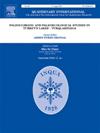Chemical composition influences δ18O of chironomid larvae head capsules - Implications for climate reconstructions
IF 1.8
3区 地球科学
Q3 GEOGRAPHY, PHYSICAL
引用次数: 0
Abstract
Oxygen isotopes of chironomid head capsules in lake sediments have become an important proxy for climate reconstructions, especially for high-latitude regions. Various chemical pretreatments have been developed to remove organic and inorganic contaminants and to clean the head capsules prior to isotope analysis, but so far there is no standardised routine method to assess the purity of the isolated chitin. We present a dataset of oxygen isotope analyses of head capsules from seven lakes in southern South America. The head capsules were assigned to three different taxonomic groups of Chironomidae (Chironominae, Orthocladiinae, Tanypodinae) and to Ceratopogonidae. Orthocladiinae exhibited on average higher isotopic fractionation relative to lake water than the other taxonomic groups, although these differences were not statistically significant. Elemental analyses demonstrate that the oxygen content and molar N/O ratio of the head capsules have a larger influence on oxygen isotopic composition than the host water isotopic composition suggesting a strong influence of incomplete deproteination on oxygen isotope values of chironomid head capsules. This is backed up by an experimental approach with differently pretreated chironomids, which exhibits a strong correlation with N/O ratio presumably due to various degrees of deproteination. According to the N/O ratio, pure chitin was obtained after removal of the minerogenic fraction with a mixture of 10 % HF and 5 % HCl (16 h, 20 °C) and subsequent treatment with 5 % NaOH (2 h) and 7 % NaClO2 (10 h). In conclusion, we recommend using the N/O ratio for purity control and a critical assessment of different pretreatment methods to obtain pure chitin in future studies.
化学成分影响摇尾蛾幼虫头囊的δ18O -气候重建的意义
湖泊沉积物中摇蚊头囊的氧同位素已成为气候重建的重要替代物,尤其是在高纬度地区。目前已开发出各种化学预处理方法来去除有机和无机污染物,并在进行同位素分析前清洁头部蒴果,但迄今为止还没有标准化的常规方法来评估分离甲壳素的纯度。我们展示了对南美洲南部七个湖泊的头部蒴果进行氧同位素分析的数据集。这些头部蒴果被归入摇蚊科(Chironomidae)的三个不同分类群(摇蚊科、Orthocladiinae、Tanypodinae)和Ceratopogonidae。与其他分类群相比,摇蚊科(Orthocladiinae)平均表现出较高的湖水同位素分馏率,但这些差异在统计学上并不显著。元素分析表明,头部蒴果的氧含量和摩尔 N/O 比对氧同位素组成的影响大于寄主水的同位素组成,这表明不完全脱蛋白对摇蚊头部蒴果的氧同位素值有很大影响。通过对不同预处理方法的摇蚊进行实验也证明了这一点,不同程度的脱蛋白作用可能导致了N/O比值的变化。根据 N/O 比率,用 10 % HF 和 5 % HCl 的混合物(16 小时,20 °C)去除矿化物部分后,再用 5 % NaOH(2 小时)和 7 % NaClO2(10 小时)处理,可获得纯甲壳素。总之,我们建议在今后的研究中使用 N/O 比率来控制纯度,并对不同的预处理方法进行严格评估,以获得纯甲壳素。
本文章由计算机程序翻译,如有差异,请以英文原文为准。
求助全文
约1分钟内获得全文
求助全文
来源期刊

Quaternary International
地学-地球科学综合
CiteScore
5.60
自引率
4.50%
发文量
336
审稿时长
3 months
期刊介绍:
Quaternary International is the official journal of the International Union for Quaternary Research. The objectives are to publish a high quality scientific journal under the auspices of the premier Quaternary association that reflects the interdisciplinary nature of INQUA and records recent advances in Quaternary science that appeal to a wide audience.
This series will encompass all the full spectrum of the physical and natural sciences that are commonly employed in solving Quaternary problems. The policy is to publish peer refereed collected research papers from symposia, workshops and meetings sponsored by INQUA. In addition, other organizations may request publication of their collected works pertaining to the Quaternary.
 求助内容:
求助内容: 应助结果提醒方式:
应助结果提醒方式:


